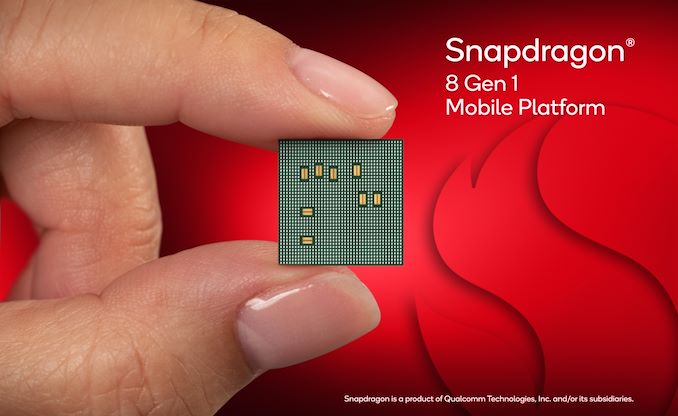The Snapdragon 8 Gen 1 Performance Preview: Sizing Up Cortex-X2
by Dr. Ian Cutress on December 14, 2021 8:00 AM ESTConclusionary Remarks: Arm v9 for Android
When we move through significant revisions of Arm’s architecture, up to v8 and now v9, it’s important to note that the new features defined in the ISA do not always fundamentally improve performance – it’s up to the microarchitecture teams to build the cores to the ISA specifications, and the implementation teams to enable the core in silicon with frequency and power efficiency. Accomplishing that requires a good process node, design technology co-optimization, and then partners that can execute by building the best devices for that processor.
Qualcomm’s target with the Snapdragon 8 Gen 1 is very clearly the 2022 Android Flagship smartphones. New cores, new graphics, enhanced machine learning capabilities, a step function in camera processing power, an integrated X65 modem, all built on Samsung’s 4nm process node technology. The flagship Android space is an area in which Qualcomm has been comfortable for a number of years, however the increased thermals of last generation’s Snapdragon S888 gave a number of analysts in the space a bit of a squeaky bum moment.
It’s hard to tell immediately in our small test if that still remains the case. Samsung’s 4nm node has improvements beyond the previous generation 5nm design, however Qualcomm’s presentational numbers were above and beyond those that Samsung provided, perhaps indicating that additional improvements both in architecture and implementation have led to those performance numbers.
Our testing shows +19% floating point performance on the X2 core, which is almost the +20% that Qualcomm quotes, but only +8% in integer, which is often the most quoted. We’re seeing power efficiency improvements for sure on the X2 core, with an overall efficiency improvement of 17%, but peak power has also increased, in part because some of our tests make use of the additional cache in the system. Our machine learning tests are +75% over the previous generation, although not the 4x numbers that Qualcomm states – we need to do more work here on power efficiency testing however. On the gaming side, our 'first run' numbers showcase some explosive gains in GPU throughput.
Although we’ve only done a few tests here, I would be remiss if I didn’t mention the elephant in the room: MediaTek. In the last month MediaTek announced a return to the high-end with a flagship processor of its own, using the same 1+3+4 configuration with slightly higher frequencies, more cache, and built on TSMC’s N4 process. Implementation here will be the key metric I feel, so how MediaTek has been able to optimize for TSMC N4 vs Qualcomm on Samsung 4nm is going to be analyzed. I should point out here that a processor is more than just the CPU cores, as we’ll see Adreno vs Mali on graphics, the different machine learning approaches, but also how the two companies approach 5G and connectivity, which has been one of Qualcomm’s most prominent strengths to date.
We look forward to testing the Qualcomm S8g1 in more detail in the New Year, as well as how many of the main smartphone OEMs choose Qualcomm for their flagship devices.












169 Comments
View All Comments
kgardas - Tuesday, December 14, 2021 - link
There are two main reason why older/second hand phone even iphone is not a good idea. (1) battery and (2) internal flash. Both getting worse and worse with the age.Glaurung - Tuesday, December 14, 2021 - link
The amount you save buying secondhand will more than cover the cost of a battery replacement.Reflex - Wednesday, December 15, 2021 - link
Yup. Get them a year or two down the line with iPhones and save way more than enough to replace the battery. I've never, ever had flash become a problem in a phone during it's usable lifespan, even the old iPhone 6S a friend uses performs just fine with iOS15. Not even worth considering that aspect.iphonebestgamephone - Tuesday, December 14, 2021 - link
You can get sd870 phones from xiaomi like the poco f3 for 400$ with 256gb rom and a much bigger battery. The support still lacks, but you'll probably get 4 years or so from custom roms.bernstein - Tuesday, December 14, 2021 - link
custom roms are awesome. But they’re for the 1% only. The other 99% require a phone thats uptodate without even pushing a virtual button.iphonebestgamephone - Wednesday, December 15, 2021 - link
Samsung it is then, though for 400$ you will only get like sd778g and 4 years support. That soc will also be good enough for the 99%.Reflex - Wednesday, December 15, 2021 - link
This, plus custom roms do not contain updated drivers and firmware to fix security issues past vendor support, they just hack the OS layer up to date.iphonebestgamephone - Friday, December 17, 2021 - link
Depends, my 2016 150$ phone has all security patches till 2021 10 01 according to snooosnitch app. though gpu drivers are from 2018. Everything works as intended too.Reflex - Monday, December 20, 2021 - link
It has the Android patches, it does not have any updates to driver or firmware security issues that have occurred since then (and there are vulns discovered all the time in that space). That's the diff. Also many of those third party Android roms significantly break the OS security model in order to run on old hardware, such as disabling checks for known vulnerable drivers.The GrapheneOS project documents a lot of what's wrong with hacked roms for older phones, and is the only third party Android ROM I would install on a device.
iphonebestgamephone - Monday, December 20, 2021 - link
Yeah its almost impossible to get those patches for specific hardware in the phone. Its usually taken from other devices with the same hardware that got the update. Graphene os severely limits phone choice though. I dont see why you wouldnt go for lineage with a wide selection.